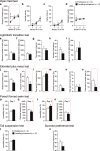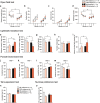Increased depression-related behavior during the postpartum period in inbred BALB/c and C57BL/6 strains
- PMID: 31399102
- PMCID: PMC6688268
- DOI: 10.1186/s13041-019-0490-z
Increased depression-related behavior during the postpartum period in inbred BALB/c and C57BL/6 strains
Abstract
Pregnancy and lactation are characterized by dramatic changes in the endocrine system and brain in mammalian females. These changes, with stress before pregnancy, are potential risk factors for the development of postpartum depression (PPD). A valid animal model of PPD is needed to understand the neurobiological basis of the depressive state of females. To explore a mouse model of PPD, we first assessed anxiety-like and depression-related behaviors in nulliparous (virgin), nonlactating primiparous, and lactating primiparous females in four inbred strains of mice (C57BL/6J, C57BL/6JJcl, BALB/cAnNCrlCrlj, and BALB/cAJcl). Pups from the nonlactating female group were removed one day after parturition to examine the effects of physical interaction with pups on the postpartum behaviors. Second, we investigated the additional effects of prepregnancy stress (restraint stress for 6 h/day for 21 days) on postpartum behaviors in the BALB/cAJcl strain. We found that females of the two BALB/c substrains showed decreased locomotor activity and increased anxiety-like and depression-related behaviors compared with females of the two C57BL/6 substrains. Behavioral differences were also observed between the two substrains of each strain. Additionally, pregnancy- and lactation-dependent behavioral differences were found in some strains: lactating BALB/cAJcl females traveled shorter distance than the females of the other reproductive state groups, while nonlactating and lactating BALB/cAJcl and C57BL/6J females showed increased depression-related behavior compared with nulliparous females. Lactating BALB/cAJcl and C57BL/6JJcl females exhibited decreased sucrose preference or anhedonia-like behavior compared with nulliparous and nonlactating females, although these results did not reach statistical significance after correction for multiple testing. An additional independent experiment replicated the marked behavioral changes in lactating BALB/cAJcl females. Moreover, increased anxiety-like behavior was observed in lactating BALB/cAJcl females that experienced prepregnancy stress. These results suggest genetic contributions to the regulation of anxiety-like and depression-related behaviors in female mice. Furthermore, this study suggests that pregnancy and lactation cause decreased locomotor activity and increased depression-related behaviors, which was consistently found in our results, and that prepregnancy stress enhances anxiety-like behavior in the BALB/cAJcl strain. The inbred strain of female mice may be used as a potential model of PPD to further study the genetic and neurobiological mechanisms underlying the development of this disorder.
Keywords: BALB/cA; C57BL/6J; Inbred substrain; Mouse model; Postpartum depression; Prepregnancy stress.
Conflict of interest statement
The authors declare that they have no competing interests.
Figures








Similar articles
-
Differential effects of stress exposure via two types of restraint apparatuses on behavior and plasma corticosterone level in inbred male BALB/cAJcl mice.Neuropsychopharmacol Rep. 2020 Mar;40(1):73-84. doi: 10.1002/npr2.12093. Epub 2019 Dec 23. Neuropsychopharmacol Rep. 2020. PMID: 31872573 Free PMC article.
-
Enhanced responsiveness to selective serotonin reuptake inhibitors during lactation.PLoS One. 2015 Feb 17;10(2):e0117339. doi: 10.1371/journal.pone.0117339. eCollection 2015. PLoS One. 2015. PMID: 25689282 Free PMC article.
-
Validity Assessment of 5 Day Repeated Forced-Swim Stress to Model Human Depression in Young-Adult C57BL/6J and BALB/cJ Mice.eNeuro. 2016 Dec 29;3(6):ENEURO.0201-16.2016. doi: 10.1523/ENEURO.0201-16.2016. eCollection 2016 Nov-Dec. eNeuro. 2016. PMID: 28058270 Free PMC article.
-
Postpartum Lactation-Mediated Behavioral Outcomes and Drug Responses in a Spontaneous Mouse Model of Obsessive-Compulsive Disorder.ACS Chem Neurosci. 2017 Dec 20;8(12):2683-2697. doi: 10.1021/acschemneuro.7b00231. Epub 2017 Oct 5. ACS Chem Neurosci. 2017. PMID: 28945961 Free PMC article.
-
Non-aversive handling in laboratory animals and its effects on depressive-like and anxiety-related behaviors: A scoping review.Physiol Behav. 2025 May 15;294:114883. doi: 10.1016/j.physbeh.2025.114883. Epub 2025 Mar 15. Physiol Behav. 2025. PMID: 40096937
Cited by
-
Reduced chronic restraint stress in mice overexpressing hyperactive proteasomes in the forebrain.Mol Brain. 2020 Jan 13;13(1):4. doi: 10.1186/s13041-020-0548-y. Mol Brain. 2020. PMID: 31931843 Free PMC article.
-
Acute and chronic effects of oral administration of a medium-chain fatty acid, capric acid, on locomotor activity and anxiety-like and depression-related behaviors in adult male C57BL/6J mice.Neuropsychopharmacol Rep. 2022 Mar;42(1):59-69. doi: 10.1002/npr2.12226. Epub 2022 Jan 7. Neuropsychopharmacol Rep. 2022. PMID: 34994529 Free PMC article.
-
Gestational Folic Acid Administration Alleviated Maternal Postpartum Emotional and Cognitive Dysfunction in Mice.Front Pharmacol. 2021 Jun 11;12:701009. doi: 10.3389/fphar.2021.701009. eCollection 2021. Front Pharmacol. 2021. PMID: 34177603 Free PMC article.
-
919 Syrup Alleviates Postpartum Depression by Modulating the Structure and Metabolism of Gut Microbes and Affecting the Function of the Hippocampal GABA/Glutamate System.Front Cell Infect Microbiol. 2021 Aug 20;11:694443. doi: 10.3389/fcimb.2021.694443. eCollection 2021. Front Cell Infect Microbiol. 2021. PMID: 34490139 Free PMC article.
-
A novel mouse model of postpartum depression using emotional stress as evaluated by nesting behavior.Sci Rep. 2021 Nov 19;11(1):22615. doi: 10.1038/s41598-021-02004-9. Sci Rep. 2021. PMID: 34799651 Free PMC article.
References
-
- Numan M, Insel TR. The neurobiology of parental behavior. New York: Springer-Verlag New York. 2006.
Publication types
MeSH terms
Substances
LinkOut - more resources
Full Text Sources
Medical

